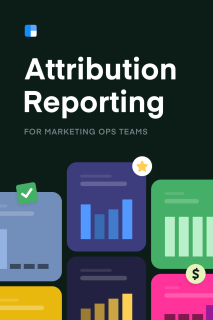Chapter 1
3 minutes
Introduction to marketing attribution
Life as a B2B marketer (and a person) in 2022 feels uncertain, to say the least.
An ongoing pandemic, talks of a possible recession, and tech companies laying off more than 24,000 employees in the first half of this year means it is definitely not business as usual. Operating with reduced headcount and budgets, marketers are facing increasing pressure to tie activity directly to revenue.
Enter marketing attribution, a key pillar of revenue-driven marketing. Attribution enables marketing teams to track the effectiveness of their initiatives and showcase their impact on the business.
If you’re reading this, I’m guessing you’re thinking about how to effectively use attribution. You may be wondering how to build the perfect multi-touch attribution model, what tech you need, or simply where to get started. If so, you’re not alone. Craig Jordan, Founder and CEO at SaaScend, shared that only 1 of his 350+ clients had an effective marketing attribution model in place.

Marketing attribution is difficult to implement because “there is not an agreed-upon one way,” says Boris Jabes, Founder and CEO at Census. Marketing attribution can and should look different across organizations. We often get caught up trying to select the perfect marketing attribution tool or model, but as Julie Beynon, Head of Analytics at Clearbit, shares, “The tech is not as important as the strategy and logic behind it.”
We put together this guide to help marketers like you make sense of attribution, show the impact of your marketing efforts, uncover insights, and ultimately drive more revenue.
We’ll explain how to:
-
Lay the foundation for successful attribution: Learn how to build an attribution model from the ground up. We’ll discuss how to implement hidden form fields, use UTM parameters to understand the effectiveness of different marketing channels, and set up a campaign hierarchy in your CRM.
-
Ask the right questions: Throw away your assumptions. Learn how to collaborate with key stakeholders, such as analysts, sales teams, and marketing peers to build and optimize your attribution model.
-
Understand different types of attribution to track marketing touchpoints throughout the buyer journey: Get a breakdown of different attribution models like first-touch, last-touch, u-shaped, time decay, and more.
-
Measure the unmeasurable: As marketers, we want to measure it all, but that isn’t always possible. This section is part reality check and part suggestions on how to understand the customer journey from a qualitative perspective.
-
Utilize reporting to find insights: Attribution models are only valuable if they produce actionable insights that help you connect the dots on what marketing campaigns are working and what aren’t. Learn how to visualize your attribution data, showcase key metrics, and find the right marketing mix to drive more revenue.
-
Build an end-to-end attribution model with examples from Clearbit and Envoy: Learn from businesses like yours. We’ll take a look at how we built marketing attribution here at Clearbit and how Envoy took a data-driven approach to their attribution modeling.
We hope this helps you on your marketing attribution journey! Take a deep breath, get comfortable, and let’s dive in.

